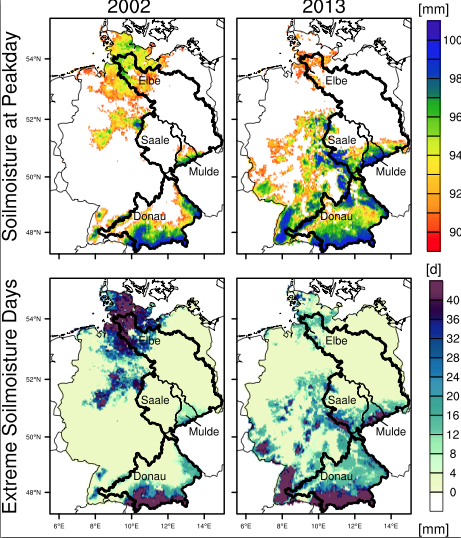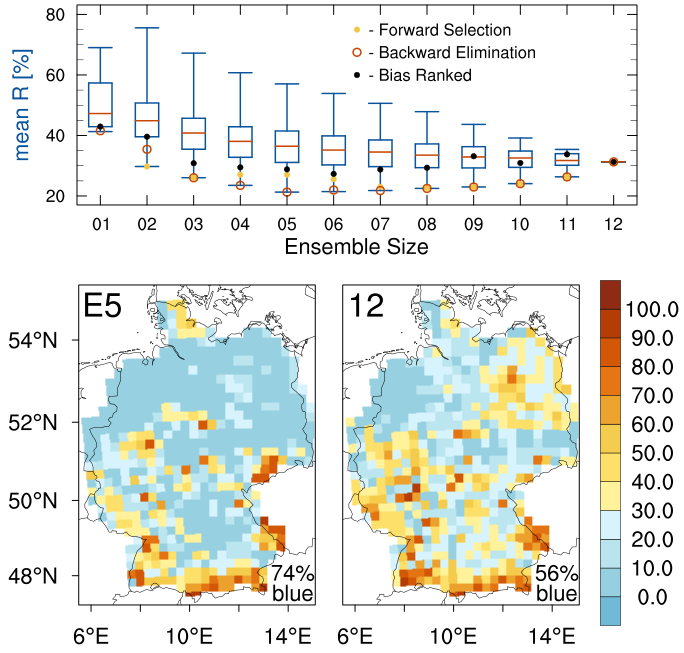REKLIM - Regional Climate Change
Comparison of 2002 and 2013 Flood events
 Figure 1: Soil moisture at peak day with values marked above 90% saturation (top row) and number of days exceeding the 95th quantile of saturation within the last 40 days prior to the event (bottom row). Left plots - 2002 event, Right plots - 2013 event.
The 2002 and the 2013 floods in the Danube and the Elbe river basins caused a havoc in Germany, with economic losses surpassing in each event the mark of 11 billion Euros. Considering the high impact of these events and the hydrometeorological records reached in both cases, it is worth trying to disentangle the impact of contributing factors of the flood generation process that lead to the development of these extreme events. Both summer events were caused by heavy rainfall triggered by low pressure systems over middle Europe (Vb and Tm circulation patterns respectively) that carry moist air from the Adriatic northeastward. Rainfall was intensified even further by orographic effects in mountainous regions. Preliminary evidence indicates that antecedent soil moisture conditions might have played a crucial role in the flood generating processes, specifically in the case of the 2013 event. To test this hypothesis, the process based hydrologic model mHM was used to estimate the top soil moisture and the surface runoff over whole Germany at a spatial resolution of 4x4 km2. mHM was forced with gridded daily precipitation and temperature, further disaggregated into hourly values. The gridded daily forcings were obtained with external drift Kriging from a dense network of meteorological stations operated by the German Weather Service. Resampling techniques were used to test the null hypothesis that the runoff generation of these two flood events is independent from antecedent soil moisture conditions. Results indicated that the soil moisture antecedent conditions, up to five days before the peak have had a statistically significant impact (p-value less than 5\%) on flood generation processes. Moreover, the elasticity of the surface runoff to antecedent soil moisture exhibited a marked difference between events and basins. These differences are more pronounced in wet conditions rather than on dry ones, which in turn highlights that soil moisture is a key factor in the generation process.
Figure 1: Soil moisture at peak day with values marked above 90% saturation (top row) and number of days exceeding the 95th quantile of saturation within the last 40 days prior to the event (bottom row). Left plots - 2002 event, Right plots - 2013 event.
The 2002 and the 2013 floods in the Danube and the Elbe river basins caused a havoc in Germany, with economic losses surpassing in each event the mark of 11 billion Euros. Considering the high impact of these events and the hydrometeorological records reached in both cases, it is worth trying to disentangle the impact of contributing factors of the flood generation process that lead to the development of these extreme events. Both summer events were caused by heavy rainfall triggered by low pressure systems over middle Europe (Vb and Tm circulation patterns respectively) that carry moist air from the Adriatic northeastward. Rainfall was intensified even further by orographic effects in mountainous regions. Preliminary evidence indicates that antecedent soil moisture conditions might have played a crucial role in the flood generating processes, specifically in the case of the 2013 event. To test this hypothesis, the process based hydrologic model mHM was used to estimate the top soil moisture and the surface runoff over whole Germany at a spatial resolution of 4x4 km2. mHM was forced with gridded daily precipitation and temperature, further disaggregated into hourly values. The gridded daily forcings were obtained with external drift Kriging from a dense network of meteorological stations operated by the German Weather Service. Resampling techniques were used to test the null hypothesis that the runoff generation of these two flood events is independent from antecedent soil moisture conditions. Results indicated that the soil moisture antecedent conditions, up to five days before the peak have had a statistically significant impact (p-value less than 5\%) on flood generation processes. Moreover, the elasticity of the surface runoff to antecedent soil moisture exhibited a marked difference between events and basins. These differences are more pronounced in wet conditions rather than on dry ones, which in turn highlights that soil moisture is a key factor in the generation process.
Read more about this topic here.
Contact: Luis Samaniego ,
Meteorological extreme events in regional climate models
This study examined the extent to which RCMs are able to represent observed extremes. For this purpose, extreme temperature and precipitation indices were calculated for twelve RCMs of the European ENSEMBLES project for the period from 1960-2000 and compared to those from observations. In addition, it was quantified to which extent an ensemble of several models is able to represent the observed indices better than individual models. The percentage share of the significant indices was selected as the criterion. In this case, the percentage "R" of indices that display a significant difference from the observations was defined at each grid cell and then the spatial mean of "R" was formed ("mean R" in Figure 2). The analysis shows that combinations of five or six models display a lower "mean R" compared to the ensemble of all models and can be found through suitable selection methods. One method initially selects the best combination of two models and adds another model step by step (forward elimination). Another method begins with the combination of all models and removes a model step by step (backward elimination). These results illustrate that even the best possible combination (E4 in Figure 2) still shows significant deviations, especially in the mountainous regions of Germany.
 Figure 2: Top: Variability of mean percentage of significant extreme indices (5% significance level) depending on ensemble size (box plots). Furthermore, the "mean R" of the combinations found using differnet selection methods is shown. Bottom: Spatial variability of the percentage of extreme indices for the best combination of five models that was selected through backward elimination (E5) as well as the ensemble of all models (12).
Figure 2: Top: Variability of mean percentage of significant extreme indices (5% significance level) depending on ensemble size (box plots). Furthermore, the "mean R" of the combinations found using differnet selection methods is shown. Bottom: Spatial variability of the percentage of extreme indices for the best combination of five models that was selected through backward elimination (E5) as well as the ensemble of all models (12).
This study is published in JoGR - Atmospheres 10.1002/2013JD020505.
Contact:
Stephan Thober
